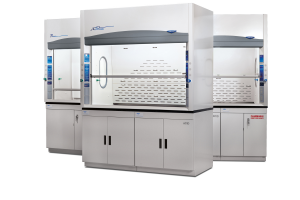
A Chemical Fume Hood (CFH) is a piece of equipment used to control the ventilation of the work area contained within. CFHs are engineering controls that are designed to mitigate volatile toxic chemicals by pulling vapors away from the user. The two major designs of CFHs are ducted and ductless, the later recirculates filtered air back into the laboratory space while the former dispenses filtered air to the outside. The vast majority of CFHs at UMBC are ducted and require an annual inspection to ensure compliance. Annual inspections include average face value readings, sash operation, and qualitative smoke testing. Annual inspections are the responsibility of the Office of Environmental Safety and Health, maintenance or replacement of a CFH is the financial responsibility of the department/person responsible for the respective CFH. Any additional inspections outside of the annual ESH scheduled inspections shall be the responsibility of the person/department requesting the inspection. It is important to understand that chemical fume hoods do not provide any protection when working with biohazardous materials. Chemical fume hoods are not equivalent to biosafety cabinets and shall never be used as a substitute for such. Under no circumstances may biohazardous material be used in a chemical fume hood. When utilizing chemical fume hoods in the laboratory, the following guidelines should be followed:
- Individuals must be trained in the proper operation, cleaning, and safe practices before starting work.
- Wear appropriate PPE such as gloves, aprons, etc. If a respirator is needed then the hood should be inspected as it may require service
- Only use a fume hood that has been inspected within one (1) year of the date listed on the orange inspection sticker. Contact ESH at 5-2918 or esh@umbc.edu if a fume hood requires inspection. Current inspection dates can be found on the UMBC Fume Hood Inspection spreadsheet.
- Operate the hood using the proper sash height. During operation keep the sash at or below the height listed on the orange inspection sticker. The sash may set above the listed height only for experimental set up if required.
- Minimize pedestrian traffic or other sources of air turbulence such as air conditioners or fans.
- Keep the hood clean and organized. Do not block airflow by placing large items in the hood or by blocking the vents. If large items are required, raise them up ~2 inches from the work surface to allow for better airflow.
- Do not remove any panels located on the inside or outside of the hood. Older fume hoods are documented to have fireproofing on panels; also, the removal of panels can interfere with proper airflow.
- Conduct experiments in the middle of the hood at least 6 inches from the sash opening to decrease the likelihood of material escaping.
- Do not use perchloric acid unless the hood and ducting is specifically designed for such use. Perchloric acid can severely damage regular fume hoods and its associated ducting.
- Close sash when done with the experiment/leaving the hood. This prudent practice conserves energy as well as provides additional containment.
- If a fume hood is not functioning properly or is believed to require maintenance, contact UMBC ESH at 5-2918 or esh@umbc.edu to schedule a test of the unit. If a fume hood requires repair, contact Facilities Management Work Control 5-2550 to schedule an appointment.
More information on fume hoods can be found utilizing the following resources
- OSHA Chemical Fume Hood Quick Facts Sheet
- CDC Fume Hood Safety Training
- UMBC Fume Hood FAQ
- Laboratory Hood Quicksheet